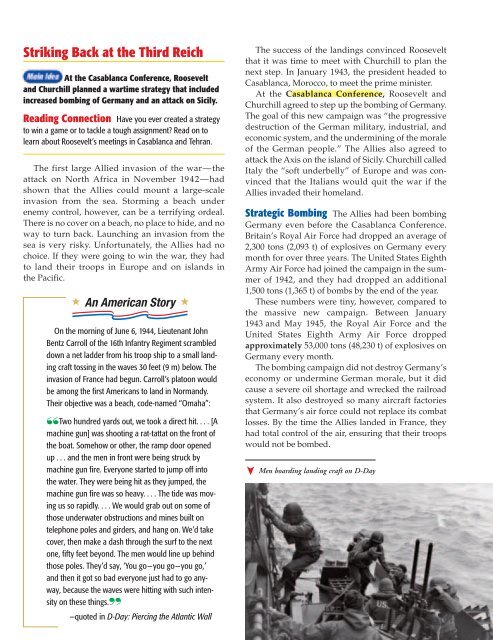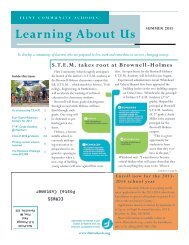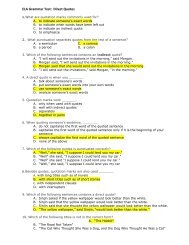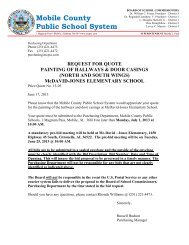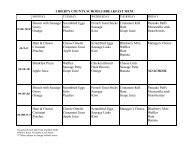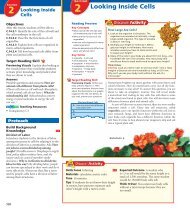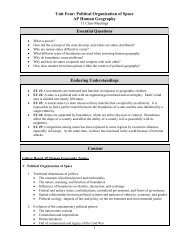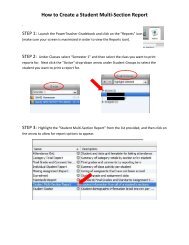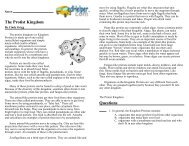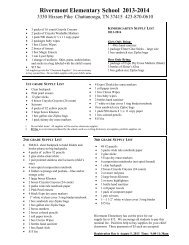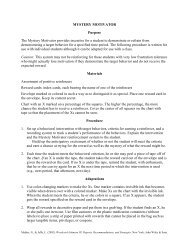Chapter 12: America and World War II, 1941-1945 - Georgia ...
Chapter 12: America and World War II, 1941-1945 - Georgia ...
Chapter 12: America and World War II, 1941-1945 - Georgia ...
You also want an ePaper? Increase the reach of your titles
YUMPU automatically turns print PDFs into web optimized ePapers that Google loves.
Striking Back at the Third Reich<br />
At the Casablanca Conference, Roosevelt<br />
<strong>and</strong> Churchill planned a wartime strategy that included<br />
increased bombing of Germany <strong>and</strong> an attack on Sicily.<br />
Reading Connection Have you ever created a strategy<br />
to win a game or to tackle a tough assignment? Read on to<br />
learn about Roosevelt’s meetings in Casablanca <strong>and</strong> Tehran.<br />
The first large Allied invasion of the war—the<br />
attack on North Africa in November 1942—had<br />
shown that the Allies could mount a large-scale<br />
invasion from the sea. Storming a beach under<br />
enemy control, however, can be a terrifying ordeal.<br />
There is no cover on a beach, no place to hide, <strong>and</strong> no<br />
way to turn back. Launching an invasion from the<br />
sea is very risky. Unfortunately, the Allies had no<br />
choice. If they were going to win the war, they had<br />
to l<strong>and</strong> their troops in Europe <strong>and</strong> on isl<strong>and</strong>s in<br />
the Pacific.<br />
On the morning of June 6, 1944, Lieutenant John<br />
Bentz Carroll of the 16th Infantry Regiment scrambled<br />
down a net ladder from his troop ship to a small l<strong>and</strong>ing<br />
craft tossing in the waves 30 feet (9 m) below. The<br />
invasion of France had begun. Carroll’s platoon would<br />
be among the first <strong>America</strong>ns to l<strong>and</strong> in Norm<strong>and</strong>y.<br />
Their objective was a beach, code-named “Omaha”:<br />
Two hundred yards out, we took a direct hit. . . . [A<br />
“<br />
machine gun] was shooting a rat-tattat on the front of<br />
the boat. Somehow or other, the ramp door opened<br />
up . . . <strong>and</strong> the men in front were being struck by<br />
machine gun fire. Everyone started to jump off into<br />
the water. They were being hit as they jumped, the<br />
machine gun fire was so heavy.... The tide was moving<br />
us so rapidly.... We would grab out on some of<br />
those underwater obstructions <strong>and</strong> mines built on<br />
telephone poles <strong>and</strong> girders, <strong>and</strong> hang on. We’d take<br />
cover, then make a dash through the surf to the next<br />
one, fifty feet beyond. The men would line up behind<br />
those poles. They’d say, ‘You go—you go—you go,’<br />
<strong>and</strong> then it got so bad everyone just had to go anyway,<br />
because the waves were hitting with such intensity<br />
on these things.<br />
”<br />
—quoted in D-Day: Piercing the Atlantic Wall<br />
The success of the l<strong>and</strong>ings convinced Roosevelt<br />
that it was time to meet with Churchill to plan the<br />
next step. In January 1943, the president headed to<br />
Casablanca, Morocco, to meet the prime minister.<br />
At the Casablanca Conference, Roosevelt <strong>and</strong><br />
Churchill agreed to step up the bombing of Germany.<br />
The goal of this new campaign was “the progressive<br />
destruction of the German military, industrial, <strong>and</strong><br />
economic system, <strong>and</strong> the undermining of the morale<br />
of the German people.” The Allies also agreed to<br />
attack the Axis on the isl<strong>and</strong> of Sicily. Churchill called<br />
Italy the “soft underbelly” of Europe <strong>and</strong> was convinced<br />
that the Italians would quit the war if the<br />
Allies invaded their homel<strong>and</strong>.<br />
Strategic Bombing The Allies had been bombing<br />
Germany even before the Casablanca Conference.<br />
Britain’s Royal Air Force had dropped an average of<br />
2,300 tons (2,093 t) of explosives on Germany every<br />
month for over three years. The United States Eighth<br />
Army Air Force had joined the campaign in the summer<br />
of 1942, <strong>and</strong> they had dropped an additional<br />
1,500 tons (1,365 t) of bombs by the end of the year.<br />
These numbers were tiny, however, compared to<br />
the massive new campaign. Between January<br />
1943 <strong>and</strong> May <strong>1945</strong>, the Royal Air Force <strong>and</strong> the<br />
United States Eighth Army Air Force dropped<br />
approximately 53,000 tons (48,230 t) of explosives on<br />
Germany every month.<br />
The bombing campaign did not destroy Germany’s<br />
economy or undermine German morale, but it did<br />
cause a severe oil shortage <strong>and</strong> wrecked the railroad<br />
system. It also destroyed so many aircraft factories<br />
that Germany’s air force could not replace its combat<br />
losses. By the time the Allies l<strong>and</strong>ed in France, they<br />
had total control of the air, ensuring that their troops<br />
would not be bombed.<br />
➤<br />
Men boarding l<strong>and</strong>ing craft on D-Day


